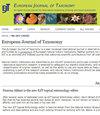标题中国长足囊蛛属五新种(蜘蛛目:囊蛛科)
IF 1.1
3区 生物学
Q3 ENTOMOLOGY
引用次数: 0
摘要
根据形态特征,对中国收集的5种Cheiracanthium C.L. Koch, 1839进行了鉴定,并将其描述为科学新种:云南的Cheiracanthium arcilongum sp. nov(♂♀)、云南的c.l circulum sp. nov(♂♀)、安徽的c.d itatum sp. nov(♂♀)、广西的c.d酒泉sp. nov(♂♀)和新疆的c.d xinjiangense sp. nov(♂♀)。此外,还提供了所有物种的习性、交配器官照片和分布图。然而,DNA条形码信息只提供了四个物种。本文章由计算机程序翻译,如有差异,请以英文原文为准。
Five new species of the long-legged sac spider genus Cheiracanthium C.L. Koch, 1839 (Araneae: Cheiracanthiidae) from China
Five species of the cheiracanthiid spider genus Cheiracanthium C.L. Koch, 1839 collected from China are diagnosed and described as new to science based on morphological characters: Cheiracanthium arcilongum sp. nov. (♂♀) from Yunnan, C. circulum sp. nov. (♂♀) from Yunnan, C. digitatum sp. nov. (♂♀) from Anhui, C. jiuquan sp. nov. (♂♀) from Guangxi and C. xinjiangense sp. nov. (♂♀) from Xinjiang. In addition, the photos of the habitus, copulatory organs and distribution map are provided for all species. However, DNA barcodes information is only provided for four species.
求助全文
通过发布文献求助,成功后即可免费获取论文全文。
去求助
来源期刊

European journal of taxonomy
ZOOLOGY-
CiteScore
2.30
自引率
8.30%
发文量
173
审稿时长
29 weeks
期刊介绍:
EJT is a fully refereed, international, fully electronic Open Access journal in descriptive taxonomy, covering subjects in zoology, entomology, botany (in its broadest sense), and palaeontology. EJT-papers must be original and adhere to high scientific (content) and technical (language, artwork, etc.) standards. Manuscripts that are clearly substandard in either of these categories will not be sent out for review. EJT is supported by a consortium of European Natural History Institutes, but its scope is global. Both authorship and geographical region of study need not be European. Authors are, however, strongly encouraged to involve European Natural History collections by consulting material or by depositing specimens (e.g. types and figured material) related to their published paper in the collection of a European Natural History Institute.
 求助内容:
求助内容: 应助结果提醒方式:
应助结果提醒方式:


